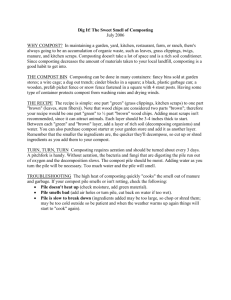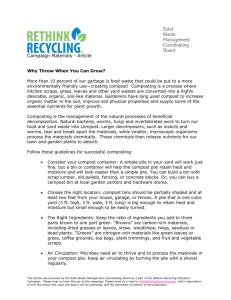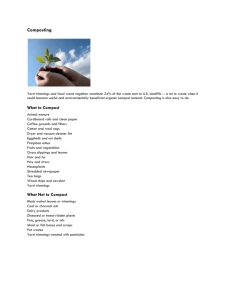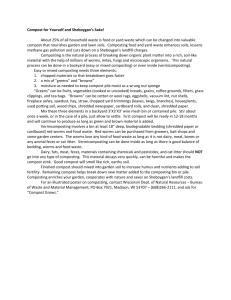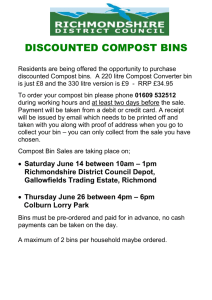Composting 101
advertisement
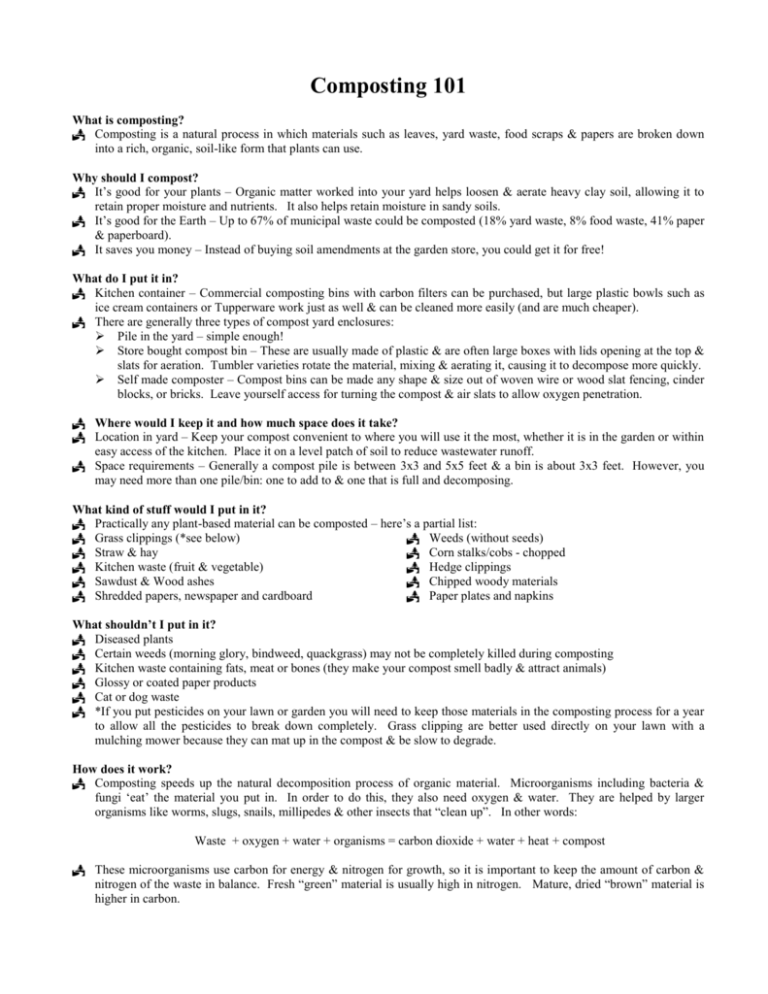
Composting 101 What is composting? Composting is a natural process in which materials such as leaves, yard waste, food scraps & papers are broken down into a rich, organic, soil-like form that plants can use. Why should I compost? It’s good for your plants – Organic matter worked into your yard helps loosen & aerate heavy clay soil, allowing it to retain proper moisture and nutrients. It also helps retain moisture in sandy soils. It’s good for the Earth – Up to 67% of municipal waste could be composted (18% yard waste, 8% food waste, 41% paper & paperboard). It saves you money – Instead of buying soil amendments at the garden store, you could get it for free! What do I put it in? Kitchen container – Commercial composting bins with carbon filters can be purchased, but large plastic bowls such as ice cream containers or Tupperware work just as well & can be cleaned more easily (and are much cheaper). There are generally three types of compost yard enclosures: Pile in the yard – simple enough! Store bought compost bin – These are usually made of plastic & are often large boxes with lids opening at the top & slats for aeration. Tumbler varieties rotate the material, mixing & aerating it, causing it to decompose more quickly. Self made composter – Compost bins can be made any shape & size out of woven wire or wood slat fencing, cinder blocks, or bricks. Leave yourself access for turning the compost & air slats to allow oxygen penetration. Where would I keep it and how much space does it take? Location in yard – Keep your compost convenient to where you will use it the most, whether it is in the garden or within easy access of the kitchen. Place it on a level patch of soil to reduce wastewater runoff. Space requirements – Generally a compost pile is between 3x3 and 5x5 feet & a bin is about 3x3 feet. However, you may need more than one pile/bin: one to add to & one that is full and decomposing. What kind of stuff would I put in it? Practically any plant-based material can be composted – here’s a partial list: Grass clippings (*see below) Weeds (without seeds) Straw & hay Corn stalks/cobs - chopped Kitchen waste (fruit & vegetable) Hedge clippings Sawdust & Wood ashes Chipped woody materials Shredded papers, newspaper and cardboard Paper plates and napkins What shouldn’t I put in it? Diseased plants Certain weeds (morning glory, bindweed, quackgrass) may not be completely killed during composting Kitchen waste containing fats, meat or bones (they make your compost smell badly & attract animals) Glossy or coated paper products Cat or dog waste *If you put pesticides on your lawn or garden you will need to keep those materials in the composting process for a year to allow all the pesticides to break down completely. Grass clipping are better used directly on your lawn with a mulching mower because they can mat up in the compost & be slow to degrade. How does it work? Composting speeds up the natural decomposition process of organic material. Microorganisms including bacteria & fungi ‘eat’ the material you put in. In order to do this, they also need oxygen & water. They are helped by larger organisms like worms, slugs, snails, millipedes & other insects that “clean up”. In other words: Waste + oxygen + water + organisms = carbon dioxide + water + heat + compost These microorganisms use carbon for energy & nitrogen for growth, so it is important to keep the amount of carbon & nitrogen of the waste in balance. Fresh “green” material is usually high in nitrogen. Mature, dried “brown” material is higher in carbon. How do I know if it’s in balance? If your compost bin is missing something from the equation, your senses will tell you. Oxygen – Decomposition can occur without oxygen (anaerobic conditions) but requires a different set of microbes & produces alcohol, acids & foul odors. It also takes a lot longer. If your compost is lacking oxygen, a simple remedy is to add more by stirring it more frequently or adding coarsely cut materials to increase the size of the air pockets. Water – Microbes can only break down moist material, so if you don’t have enough water, decomposition will slow down. If it’s too soggy, there will be less air space for oxygen & things will slow down too. Microbes function best when the materials are as damp as a wrung out sponge. Waste (Browns and Greens) If your carbon/brown materials outnumber your nitrogens/greens then your pile will smell fine, but not much will be happening. The pile will be cool & you won’t see it getting smaller. Stir in some more “greens” & in a few days it will start heating up. If your nitrogens/greens outnumber your carbons/browns, then your pile will be very damp & smell badly. Stir/turn the pile more frequently & add some more browns like dried leaves or shredded papers. Will it stink? If everything is running smoothly, your compost should smell earthy or like the vegetable section of the grocery store. If there is an imbalance between the carbon and nitrogen or a lack of oxygen, the compost will start to smell badly. The good news is that correcting the imbalance will make your compost smell earthy again. Will bugs or animals getting into it? Animals should not be getting in the compost if you are not adding fats or meats, but there will likely be some insects as these are part of the natural decay process. Stirring in food waste when it is added will help reduce insect populations. How long does it take? It depends on how often you stir it. The more frequently you stir, the faster the process. Times range from about 3 weeks for tumblers to one year for a pile to get useable compost. What do I do with the dirt that comes out? Compost can be added to your garden, lawn, flower beds, even potted plants. What happens in the winter? The pile goes dormant when the temperature is less than 50F, but the freeze-thaw cycles help break down vegetable matter & the process will resume when the temperature warms up again. Vermicomposting The process of using worms & micro-organisms to turn kitchen waste into a black, earthy-smelling, nutrient-rich humus Useful during the winter months when primarily only kitchen waste is generated. You need 5 basic ingredients: a container bedding water worms non-fatty kitchen scraps. In 3-4 months, the worms will have digested nearly all the garbage & bedding & the bin will be filled with a rich, black natural fertilizer & soil amendment. Compared to ordinary soil, the worm castings contain: 5 times more nitrogen 7 times more phosphorus 11 times more potassium. They are rich in humic acids & improve the structure of the soil. Sources http://lancaster.unl.edu/pest/resources/vermicompost107.shtml 2009 Penn State Master Gardener Manual http://backyardcompost.cas.psu.edu/howiscompostmade/how_is_compost_made.html



